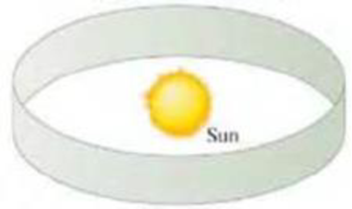
Concept explainers
A science-fiction tale describes an artificial “planet” in the form of a band completely encircling a sun (Fig. 6–31). The inhabitants live on the inside surface (where it is always noon). Imagine that this sun is exactly like our own, that the distance to the band is the same as the Earth–Sun distance (to make the climate temperate), and that the ring rotates quickly enough to produce an apparent gravity of g as on Earth. What will be the period of revolution, this planet’s year, in Earth days?

FIGURE 6-31
Problem 69.
Want to see the full answer?
Check out a sample textbook solution
Chapter 6 Solutions
EBK PHYSICS FOR SCIENTISTS & ENGINEERS
Additional Science Textbook Solutions
Essential University Physics: Volume 1 (3rd Edition)
The Cosmic Perspective
Essential University Physics: Volume 2 (3rd Edition)
The Cosmic Perspective Fundamentals (2nd Edition)
College Physics
Life in the Universe (4th Edition)
- Estimate the gravitational force between two sumo wrestlers, with masses 220 kg and 240 kg, when they are embraced and their centers are 1.2 m apart.arrow_forwardA geosynchronous Earth satellite is one that has an orbital period of precisely 1 day. Such orbits are sueful for communication and weather observation because the satellite remains above the same point on Earth (provided it orbits in the equatorial plane in the same direction as Earth’s rotation). Calculate the radius of such an orbit based on the data for Earth in Appendis D.arrow_forwardA Molniya orbit is a highly eccentric orbit of a communication satellite so as to provide continuous communications coverage for Scandinavian countries and adjacent Russia. The orbit is positioned so that these countries have the satellite in view for extended periods in time (see below). If a satellite in such an orbit has an apogee at 40,000.0 km as measured from the center of Earth and a velocity of 3.0 km/s, what would be its velocity at perigee measured at 200.0 km altitude?arrow_forward
- Using the technique shown in Satellite Orbits and Energy, show that two masses m1 and m2 in circular orbits about their common center of mass, will have total energy E=K+E=K1+K2Gm1m2r=Gm1m22r . We have shown the kinetic energy of both masses explicitly. (Hint: The masses orbit at radii r1 and r2 , respectively, where r=r1+r2 . Be sure not to confuse the radius needed for centripetal acceleration with that for the gravitational force.)arrow_forwardCircular orbits in Equation 13.10 for conic sections must have eccentricity zero. From this, and using Newton’s second law applied to centripeta acceleration, show that the value of in Equation 13.10 is given by Where is the angular momentum of the orbiting body. The value of is constant and given by this expression regardless of the type of orbit.arrow_forwardCheck Your Understanding By what factor must the radius change to reduce the orbital velocity of a satellite by one-half? By what factor would this change the period?arrow_forward
- An object of mass m is located on the surface of a spherical planet of mass M and radius R. The escape speed from the planet does not depend on which of the following? (a) M (b) m (c) the density of the planet (d) R (e) the acceleration due to gravity on that planetarrow_forwardUsing Figure 13.9, carefull sketch a free body diagram for the case of a simple pendulum hanging at latitude lambda, labeling all forces acting on the point mass,m. Set up the equations of motion for equilibrium, setting one coordinate in the direction of the centripetal accleration (toward P in the diagram), the other perpendicular to that. Show that the deflection angle , defined as the angle between the pendulum string and the radial direction toward the center of Earth, is given by the expression below. What is the deflection angle at latitude 45 degrees? Assume that Earth is a perfect sphere. tan(+)=gg2REtan , where is the angular velocity of Earth.arrow_forwardAn Earth satellite has its apogee at 2500 km above the surface of Earth and perigee at 500 km above the surface of Earth. At apogee its speed is 730 m/s. What is its speed at perigee? Earth’s radius is 6370 km (see below).arrow_forward
 University Physics Volume 1PhysicsISBN:9781938168277Author:William Moebs, Samuel J. Ling, Jeff SannyPublisher:OpenStax - Rice University
University Physics Volume 1PhysicsISBN:9781938168277Author:William Moebs, Samuel J. Ling, Jeff SannyPublisher:OpenStax - Rice University Glencoe Physics: Principles and Problems, Student...PhysicsISBN:9780078807213Author:Paul W. ZitzewitzPublisher:Glencoe/McGraw-Hill
Glencoe Physics: Principles and Problems, Student...PhysicsISBN:9780078807213Author:Paul W. ZitzewitzPublisher:Glencoe/McGraw-Hill Physics for Scientists and Engineers: Foundations...PhysicsISBN:9781133939146Author:Katz, Debora M.Publisher:Cengage Learning
Physics for Scientists and Engineers: Foundations...PhysicsISBN:9781133939146Author:Katz, Debora M.Publisher:Cengage Learning Principles of Physics: A Calculus-Based TextPhysicsISBN:9781133104261Author:Raymond A. Serway, John W. JewettPublisher:Cengage Learning
Principles of Physics: A Calculus-Based TextPhysicsISBN:9781133104261Author:Raymond A. Serway, John W. JewettPublisher:Cengage Learning College PhysicsPhysicsISBN:9781305952300Author:Raymond A. Serway, Chris VuillePublisher:Cengage Learning
College PhysicsPhysicsISBN:9781305952300Author:Raymond A. Serway, Chris VuillePublisher:Cengage Learning Classical Dynamics of Particles and SystemsPhysicsISBN:9780534408961Author:Stephen T. Thornton, Jerry B. MarionPublisher:Cengage Learning
Classical Dynamics of Particles and SystemsPhysicsISBN:9780534408961Author:Stephen T. Thornton, Jerry B. MarionPublisher:Cengage Learning





